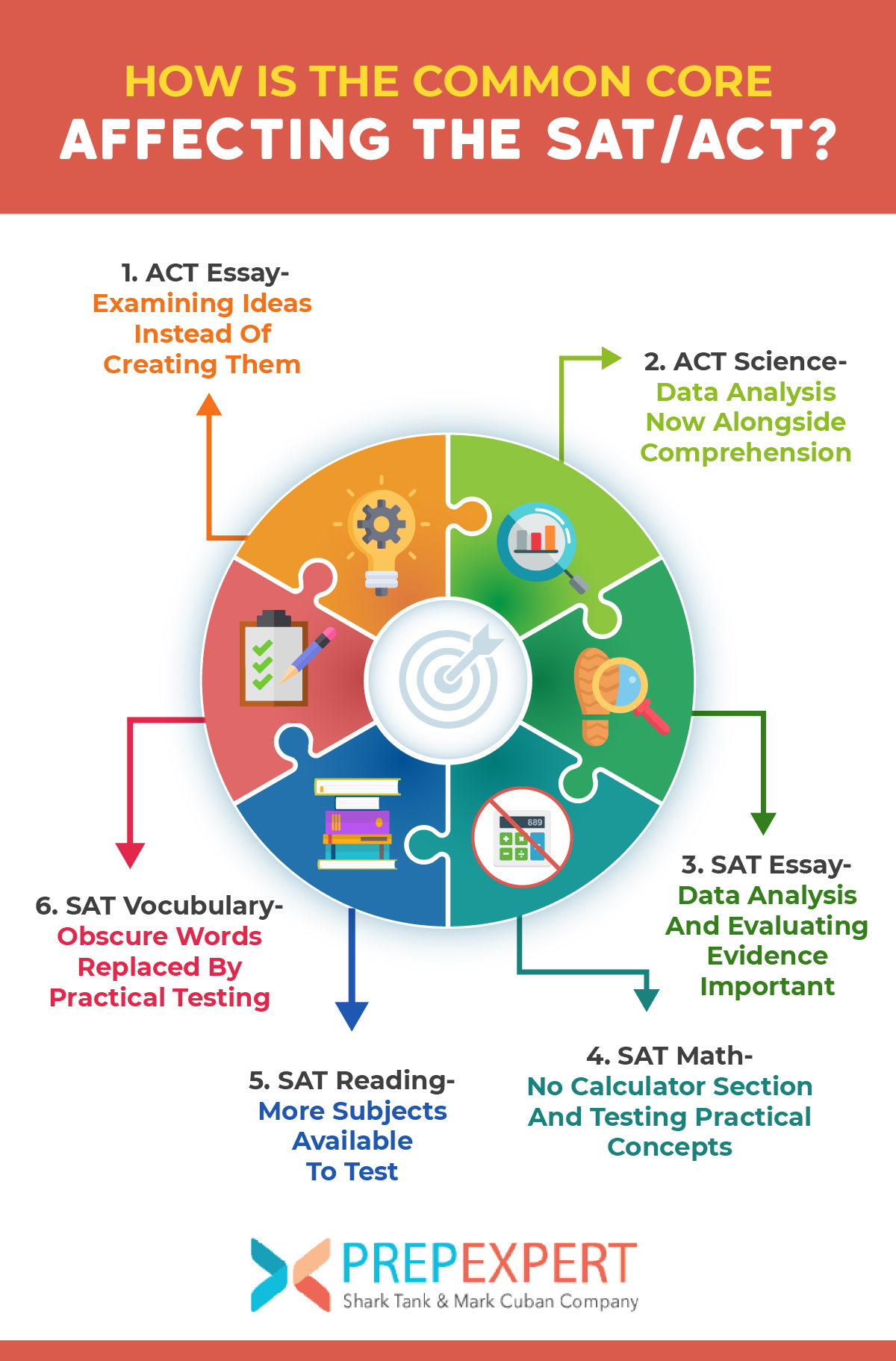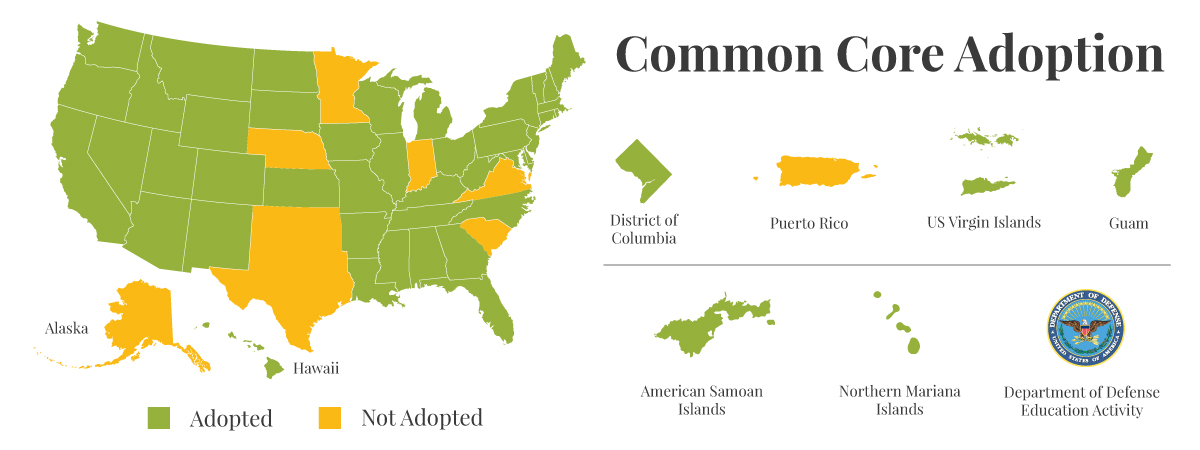How Is Common Core Affecting The SAT/ACT
Common Core’s widespread adoption has unintentionally weakened the ACT and SAT, by ignoring desired college-level skills like critical thinking in favor of straightforward data analysis.
By overemphasizing “real-world application” versus academic rigor, Common Core’s effect on both the SAT and ACT could leave students less prepared for college and career more than they realize.
If you want to make sure your child is ready for the SAT or ACT, no matter how they’re affected by Common Core standards, then be sure to sign him or her up for either our SAT prep or ACT prep courses.
[sat_one]

At a glance, here are some examples of how Common Core has reshaped the ACT vs. SAT:
| ACT | Pre-Common Core | Post-Common Core |
|---|---|---|
| Essay | Students were asked to take a position via the stated prompt and defend it with their own reasoning and examples. The emphasis was on forcing students to generate their own ideas and defend them with sound reasoning. | The prompt presents student with multiple perspectives on a topic, asks them to then analyze each one and present their own perspective to examine in conjunction with the others. This shift emphasizes analysis over critical thinking. |
| Science | Students answered questions on their general comprehension of specific subject matter. Subjects tested included Biology, Chemistry, Physics, etc. | New multi-part questions now require students to make inferences by examining the provided data. In addition to general comprehension, students are now must demonstrate clear data analysis. |
| Reading | Students read four presented selections and answered 10 questions per selection within a 35-minute timeframe. | The inclusion of new passage comparison questions demands that students demonstrate reasoning and data analysis skills instead of comprehension. |
| SAT | Pre-Common Core | Post-Common Core |
| Evidence Citation | Students were not asked to cite and analyze any presented evidence. | Students are presented with reading and writing multiple-choice questions that require examining presented facts. |
| Reading Passages | The previous SAT Reading and Writing sections represented a fairly narrow range of subjects. | Revamped Reading and Writing sections now include material drawn from a wider range of sources including science and social studies. This falls in line with Common Core’s emphasis on presenting more non-literary sources in English. |
| Vocabulary Section | Students were presented with obscure words that tested their knowledge and comprehension of little-used vocabulary. | The new section presents general, practical words, reflecting the Common Core belief of shaping education for practical college and career application. |
| Essay Section | The previous section allowed students to draw upon their own experiences and ideas, in order to respond to the provided prompt. | The new section tests students’ ability to analyze and evaluate evidence. The prompt asks students to analyze presented information and examine how the author came to his or her conclusion. |
| Math Section | The previous version presented and tested students on a wide variety of high school-level math concepts. Logic-based word problems and full calculator usage were also notable features. | The new Math section now includes “No Calculator” questions and has eliminated logic-based word problems in favor of testing practical concepts such as Geometry, Algebra, etc. versus the old version’s wider range of material. |
| Data Analysis | The previous version did not test for data interpretation and analysis whatsoever. | The new version includes charts and tables in its Reading and Writing sections, which forces students to analyze them and draw conclusions. Again, critical thinking is ignored in favor of strict analysis. |
| Document Interpretation | In the previous version, students were exposed to obscure literary texts to examine and draw their own interpretations. | In the new version, students examine and interpret well-known US documents. This shift reflects Common Core’s de-emphasis on literary sources and the grade 9-10 standard for students to analyze seminal U.S. documents. |

Common Core’s Background & Intention
A major change that occurred in US education over the past decade was the development and adoption of the Common Core State Standards curriculum, more commonly known as “Common Core”.
This initiative, currently adopted by 42 states, was designed to provide clear standards for both knowledge and skills that K-12 students should have to prepare them for college and their future careers. However, it has also played a role in changing both the SAT and ACT tests.

Common Core’s Hidden Problems
Despite its good intentions, Common Core has come under attack over the past few years for a number of reasons.
First, many have argued that despite the stated intention of better preparation for the college-level study, the curriculum’s heavy emphasis on nonfiction and strictly informational reading reduces a student’s ability to understand complex literary texts.
Research has shown that students with the highest level of college readiness normally are experienced in reading and interpreting classical literature along with other complex literary material. The de-emphasis on literary interpretation and idea generation often hurts students once they take college-level courses that require those skills.
[sat_two]
Second, Common Core effectively eliminates eighth-grade Algebra, in favor of a broader, general concepts course. By degrading math instruction at this level, students looking to pursue a math or science-based degree are often forced to seek remedial instruction. Often, this is the only way they can prepare for calculus and other high-level math concepts that STEM fields require.

ACT Essay – Examining Ideas Instead Of Creating Them
Again, Common Core emphasizes source-based writing and research, instead of helping students logically develop their own original arguments.
This sea change is clearly reflected in the updated ACT Essay. The new version is longer and is concerned with mainly examining the evidence, rather than testing a student’s critical thinking and creativity.
Unfortunately, molding students’ research and analysis skills to this degree can actually backfire in college. According to research released by ACT via its 2016 National Curriculum Survey, college professors indicated greater interest in a student’s ability to generate unique and sound ideas rather than the source-based writing skills that Common Core emphasizes.

Additional Common Core-Inspired ACT Changes
Besides the clear shift in its Essay section, Common Core standards have quietly affected other ACT sections.
The revised Science section’s emphasis on data analysis via new multi-part questions illustrates that examining information is now important too. While demonstrating comprehension was great before, today you have to both comprehend and effectively interpret information in order to score well.
The Reading section overall has stayed intact despite the new passage comparison questions. The Math and English sections have also remained mostly intact. The English section still places heavy emphasis on demonstrating grammar knowledge, instead of Common Core’s focus on analysis, communication and “digital literacy”. ACT’s Math format remains effectively untouched too.
In short, if you were to compare the ACT pre-Common Core and post-Common Core, the overall structure remains intact with only a few notable adjustments. Any student looking to take the ACT now though needs to be aware that general knowledge and comprehension alone is no longer enough to score high.

SAT Revamped By Common Core
The SAT though, as the changes above reflect, was dramatically reshaped in 2016, using Common Core as a guide to retool and drop sections.
[leadmagnet_two]
In truth, this isn’t too surprising when you consider the fact that David Coleman, the current head of College Board, which administers the SAT, was previously a member of Common Core’s English Language Arts committee. Referred to often as Common Core’s architect, Coleman actively campaigned to revamp the test, since joining College Board in 2012.

Common Core’s Good Intentions Backfire
It’s clear to see that Common Core has stamped itself on the two most common admission tests colleges use to evaluate potential students, which may lead to unintentionally negative results.
An argument can be made that despite being well-intentioned, the curriculum’s standards, in fact, hinder student preparation by unintentionally focusing more on career-preparation than higher learning.
Consider what theoretical physicist Lawrence Krauss recently said when giving his own thoughts on how to approach education and creative thinking:
“Being able to know specifics to pass a test is not the same as being able to understand how to go about answering those questions.”

Where The SAT, ACT, & Colleges Go From Here
It is still too early to tell how these Common Core-inspired changes will affect students’ ability to handle college-level coursework but there is a real fear to consider.
Again, despite enacting some changes based on Common Core’s values, the ACT remains practically intact. However, the SAT’s recent revamp shows a clear course correction that will affect current and future high school graduates applying for college.
The fear is that colleges will be forced to reduce their own academic standards and turn out graduates less prepared for the real world than previous generations. By trying to prepare students more practically for life, Common Core and its effects on the ACT and SAT, may, in fact, have the opposite effect for years to come.
[sat_three]
For more test strategy, college admissions, and scholarship application tips sign up for our FREE class happening right now!
Common Core FAQ
How has Common Core affected the SAT and ACT?
Common Core’s widespread adoption has unintentionally weakened the ACT and SAT, by ignoring desired college-level skills like critical thinking in favor of straightforward data analysis.
Why does Common Core exist?
This initiative, currently adopted by 42 states, was designed to provide clear standards for both knowledge and skills that K-12 students should have to prepare them for college and their future careers.
What’s a common complaint about how Common Core has caused problems?
Many have argued that despite the stated intention of better preparation for the college-level study, the curriculum’s heavy emphasis on nonfiction and strictly informational reading reduces a student’s ability to understand complex literary texts.
What is the problem with Common Core weakening the SAT and ACT?
The fear is that colleges will be forced to reduce their own academic standards and turn out graduates less prepared for the real world than previous generations.